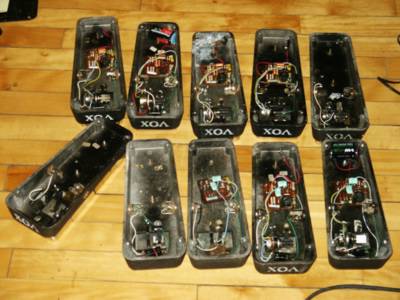
The Clyde McCoy Clan

I've recently had the rare experience of working on 10 old Vox Clyde McCoy wah-wah pedals. This family of old Clyde McCoys belongs to Billy Corgan of the Smashing Pumpkins.
Old wah pedals change sound as the resistive track of the potentiometer wears down from constant use and gets thinner. The original value of the pot is 100k and this can increase up to 3 or 4 megohms until the pot finally gives out and becomes an open circuit. If you replace the old pot with a new one the difference can be quite remarkable.
The limited movement of the pedal means that the pot can only operate over two thirds of its full range. The original pot has a custom taper designed to go from 0 to 100% of its value in exactly this limited range. The last 30% is never used. In other words the pot is fully open when it is turned up to 2 thirds and has no further effect if you turn it all the way to the end. This gives you a bit of leeway when you adjust it. If the sound is too bright when the pedal is all the way down you can back off the pot a bit.By the way, I prefer the more common circuit design since I like the top end.